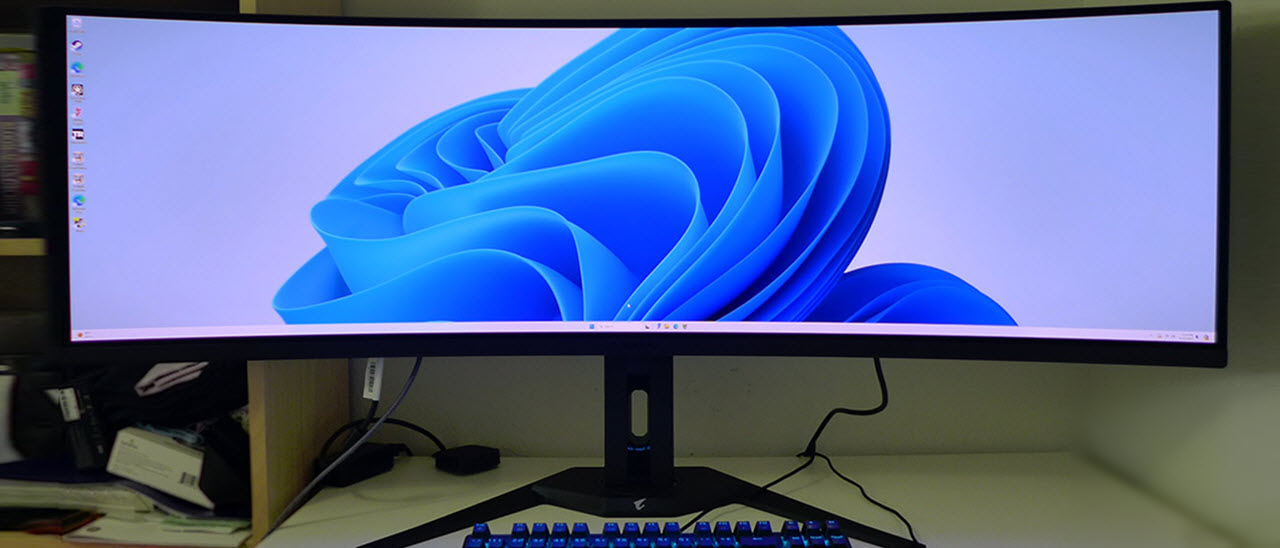Why you can trust Tom's Hardware
OLED as a category is proving to be very color-accurate, with most examples not requiring calibration. The CO49DQ is no different. It’s spot-on in its Eco picture mode.
Grayscale and Gamma Tracking
Our grayscale and gamma tests use Calman calibration software from Portrait Displays. We describe our grayscale and gamma tests in detail here.
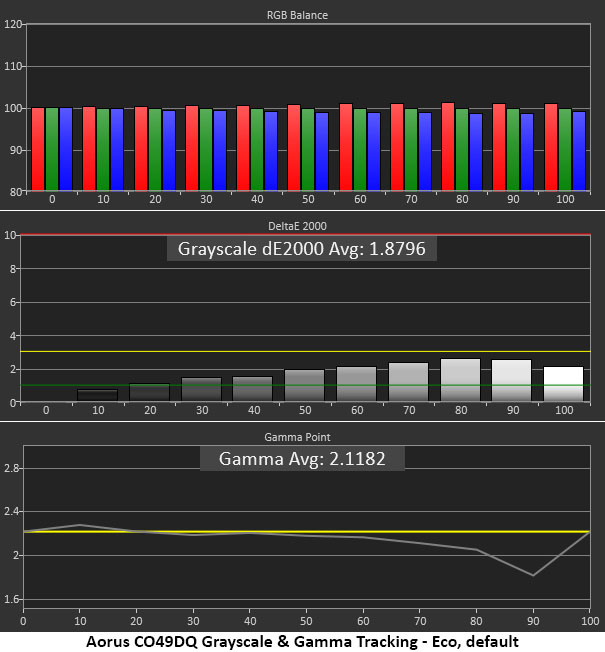
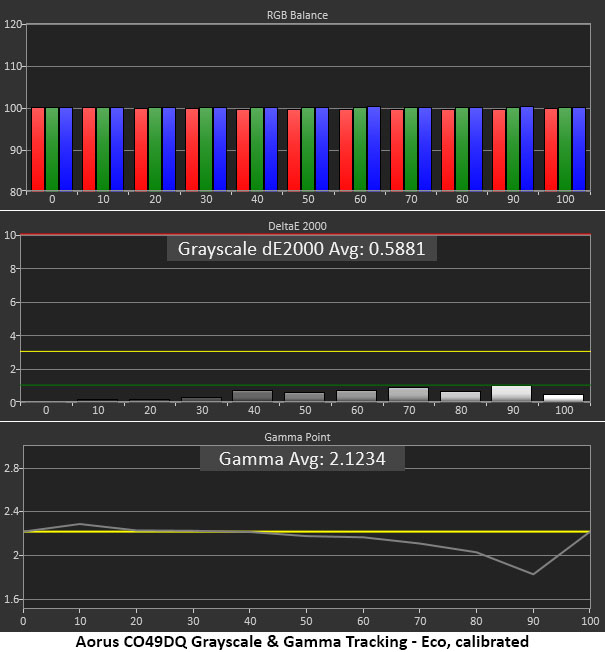
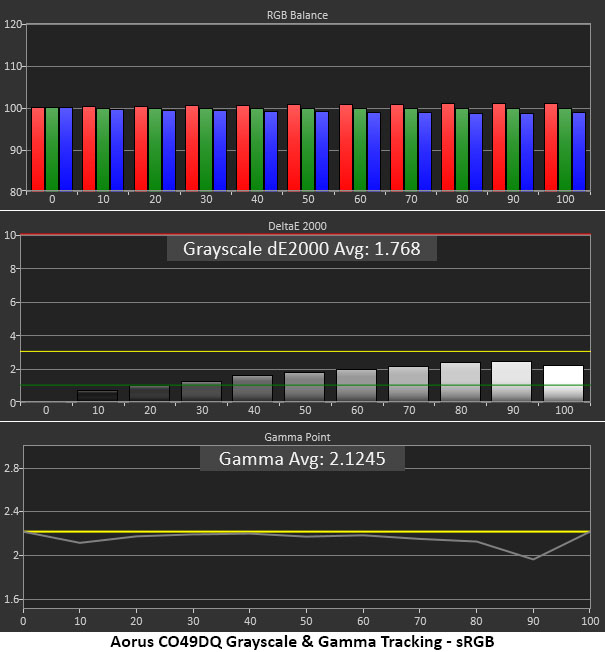
The CO49DQ’s first chart shows visually perfect grayscale tracking with no errors above 3dE. However, gamma is off the mark with too-light values at 80 and 90%. This doesn’t have a huge impact on picture quality, but I found some highlights looked slightly washed out in some content. It’s not a significant issue but could be fixed with a firmware update. Calibration lowers the grayscale error but does not change gamma tracking.
sRGB also has visually perfect grayscale with gamma that’s closer to the mark. Based on this test, it’s completely usable but as you’ll see below, there is a gamut accuracy issue in the blue primary.
Comparisons

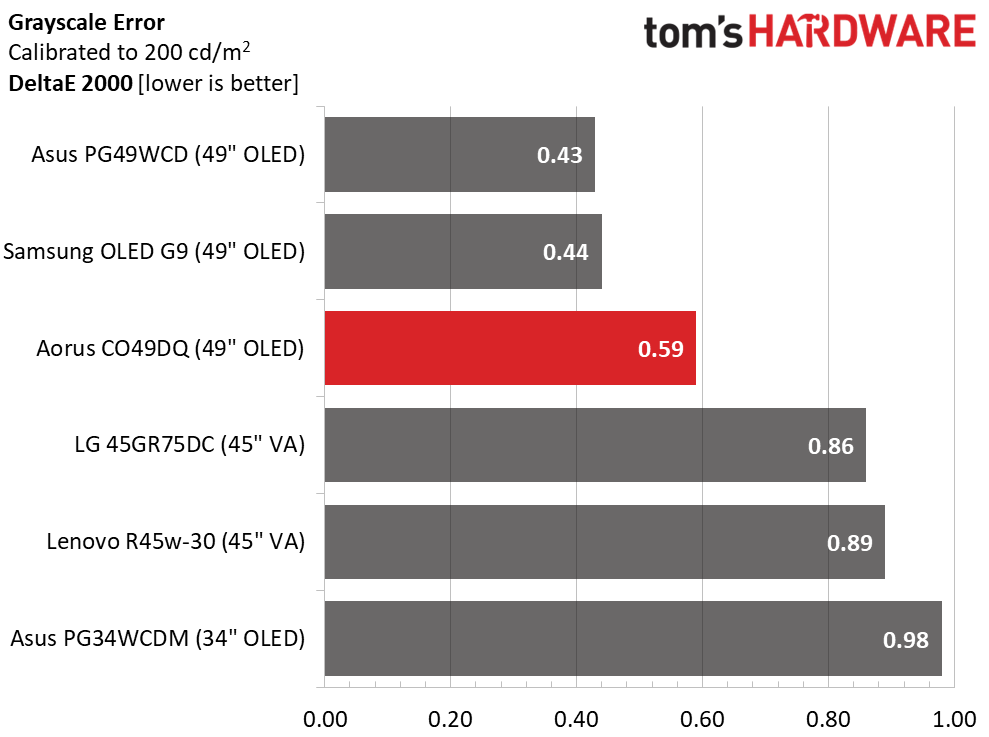
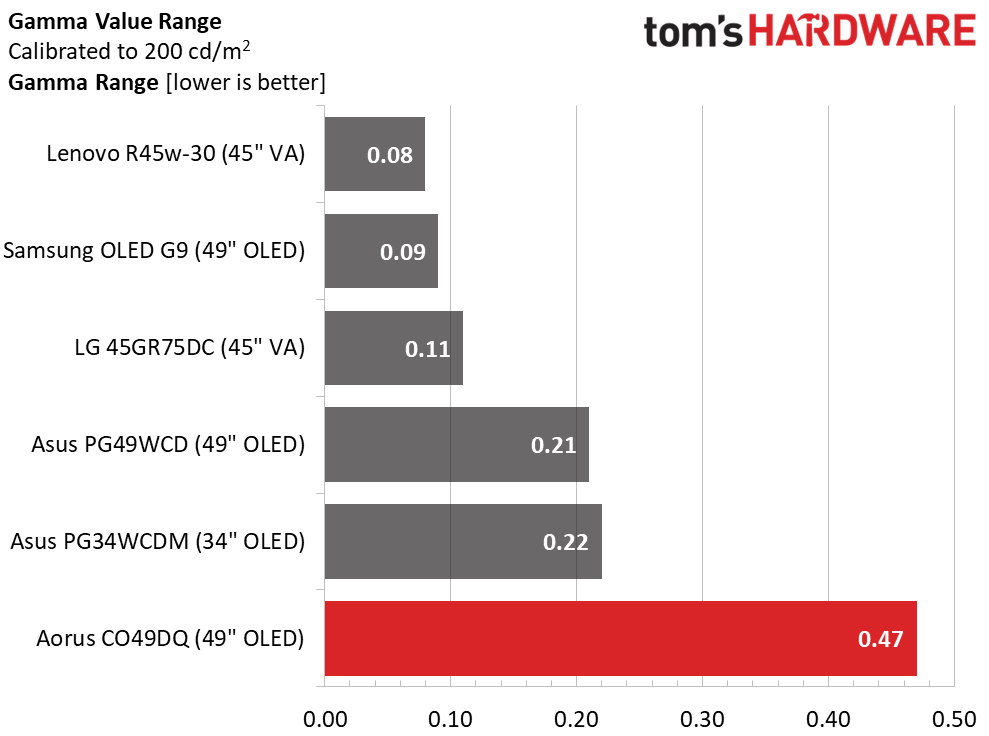
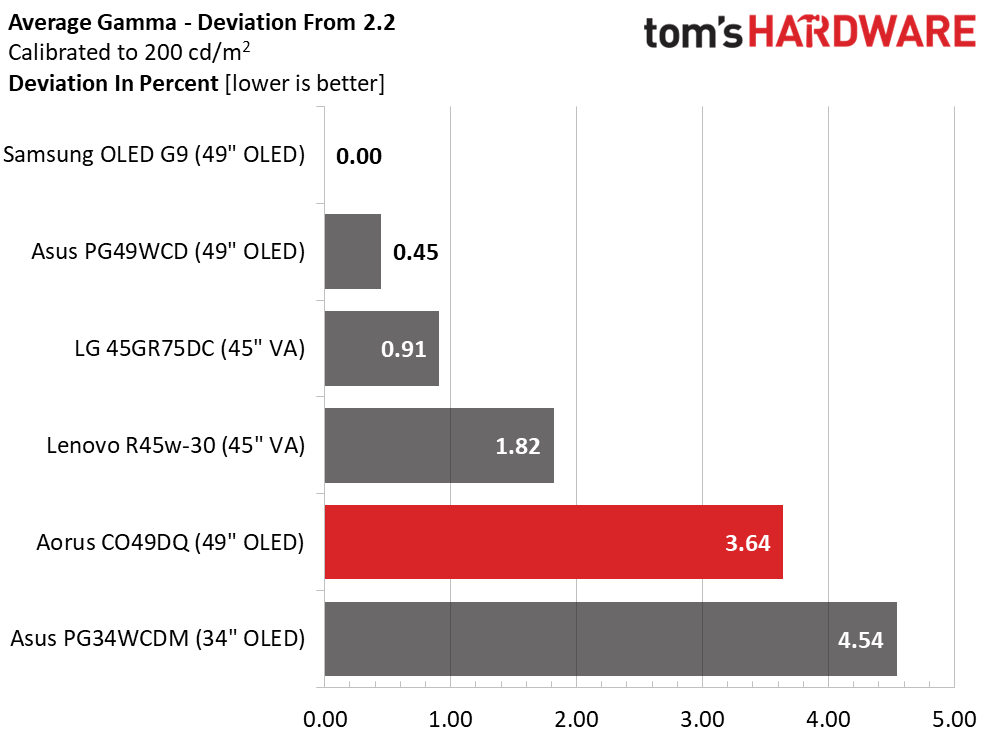
You can see the excellent out-of-box results posted by the four OLEDs here. The CO49DQ sits third but since the error is invisible, there is no difference between the screens. None of them need calibration. A few tweaks lower the number so that all monitors are visually perfect.
The gamma issue I noted lowers the CO49DQ's ranking. Most of the trace is on the reference line, but the 80% and 90% steps spoil the result. Visually, you’ll see some highlights that are a tad washed out. It’s not quite a deal breaker, but since OLED monitors are so close in performance, it’s worth fixing with a firmware update. The 3.64% deviation equates to an actual value of 2.12.
Color Gamut Accuracy
Our color gamut and volume testing use Portrait Displays’ Calman software. For details on our color gamut testing and volume calculations, click here.
Get Tom's Hardware's best news and in-depth reviews, straight to your inbox.
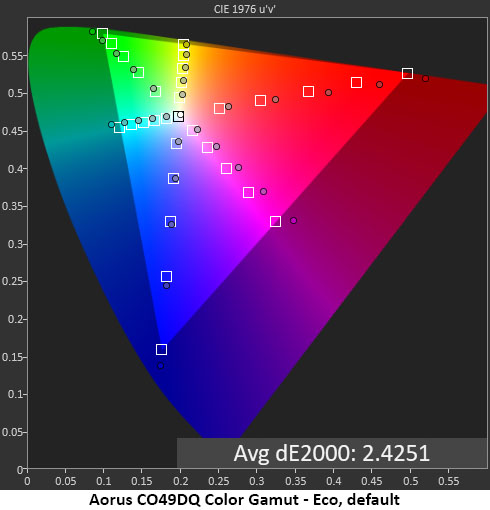
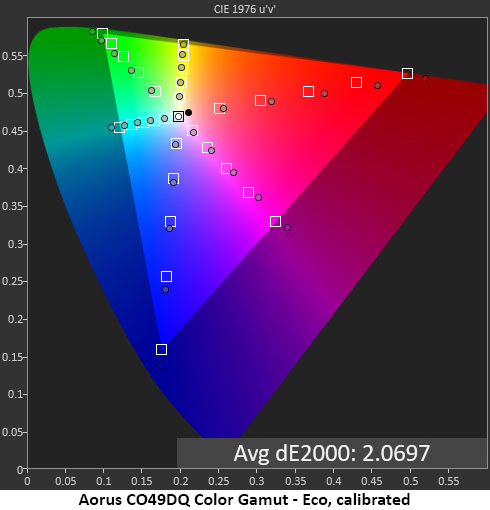
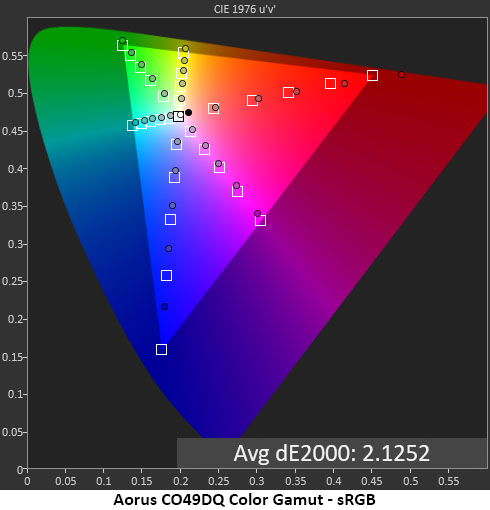
The CO49DQ is fairly close to perfect out of the box in the gamut accuracy test. Red and green are a bit over-saturated, which no one will complain about. Magenta is a little off-hue, which is also a minor issue. The gamut is so large that this is expected behavior. Saturation points are linear, which means every shade is over-saturated by the same amount, and balance is maintained. Calibration brings the secondary colors in line for a slight improvement in the error value.
The sRGB mode has a couple of issues. First, the blue primary is under-saturated, especially above 50%. At 100% stimulus, it only hits 90% saturation. Red is around 10% over-saturated as well. Hue targets are fine, so the overall image is good but not great. The sRGB mode is OK for gaming but too far off spec for critical applications. The CO49DQ should be considered a DCI-P3-only monitor.
Comparisons


The CO49DQ’s 2.07dE gamut score is referenced to the DCI-P3 spec. sRGB color is at 2.13dE, which sounds fine on the surface, but the under-saturated blue primary is a problem for color-critical work. For gamers, though, there is more than enough accurate color to satisfy.
The CO49DQ is officially the most colorful OLED I’ve reviewed, with 114.66% coverage of DCI-P3. The only way to see more color is with a couple of Mini LED screens I’ve measured with Acer’s Predator X32 at the tip-top with 119.7%. At this level, you’re looking at a tremendously colorful monitor. The CO49DQ is accurate enough for grading work in the DCI-P3 realm. Though sRGB color seems ideal at 102.45%, its under-saturated blue primary is a problem if accuracy is a priority.
Test Takeaway: The CO49DQ is the most colorful OLED of any size or shape I’ve tested. But its sRGB errors mean it is strictly a DCI-P3 monitor. In that realm, it is very accurate and does not require calibration. For gaming, it presents a stunning image, and you won’t need to do anything besides unpack it and set brightness to taste.
MORE: Best Gaming Monitors
MORE: How We Test PC Monitors
MORE: How to Buy a PC Monitor
MORE: How to Choose the Best HDR Monitor
Current page: Grayscale, Gamma and Color
Prev Page Brightness and Contrast Next Page HDR Performance
Christian Eberle is a Contributing Editor for Tom's Hardware US. He's a veteran reviewer of A/V equipment, specializing in monitors. Christian began his obsession with tech when he built his first PC in 1991, a 286 running DOS 3.0 at a blazing 12MHz. In 2006, he undertook training from the Imaging Science Foundation in video calibration and testing and thus started a passion for precise imaging that persists to this day. He is also a professional musician with a degree from the New England Conservatory as a classical bassoonist which he used to good effect as a performer with the West Point Army Band from 1987 to 2013. He enjoys watching movies and listening to high-end audio in his custom-built home theater and can be seen riding trails near his home on a race-ready ICE VTX recumbent trike. Christian enjoys the endless summer in Florida where he lives with his wife and Chihuahua and plays with orchestras around the state.
-
parkerthon Really interesting, and finally a price that has me seriously considering try an oled monitor ultra wide. But being that my desktop is used for my job 95% of the time, which often requires Teams screen sharing of presentations, I’m trying to wrap my head around how that would work. Is there a way to virtually split my desktop for powerpoint presentation mode that throws slides on one screen and a presenters view on another? I use this a lot. I do see some third party utilities that might do this, but curious if anyone out there has experience with this.Reply -
Giroro This is wider than the last-reviewed ASUS PG34WCDM, less expensive, and much less curved.Reply
It seems to have a lot going on.
I would need to see the curve in person, because it is such a hard thing to convey through pictures.
I wish best buy had better variety to their in-store displays. -
PEnns Seems like a really good monitor. But I have to ask: Does it really have to be curved? The size is (allegedly) the same, so why the curve? Curved might be more tolerable at 32", but 49" is a bit too much (IMHO).Reply
Or maybe the main consideration for some: More immersive? Well, maybe, but many will get the same experience from the same 49" monitor and most likely it will be less expensive! -
AkroZ Reply
There is many advantages to the curve.PEnns said:Seems like a really good monitor. But I have to ask: Does it really have to be curved? The size is (allegedly) the same, so why the curve? Curved might be more tolerable at 32", but 49" is a bit too much (IMHO).
Or maybe the main consideration for some: More immersive? Well, maybe, but many will get the same experience from the same 49" monitor and most likely it will be less expensive!
Firstly for this screen of 49 inch it reduce the width to 47 inch with better readability, your eyes need less distance to find the corners.
On a flat screen the center is good but due to the angles of view the pixels becomes more and more deformed on the edges and smaller (from the viewer perspective), this also reduce the perceived lights making the corners darker.
Those makes corners more difficult to read. Here it's a curved 1800R screen, if you place your eyes at 1,8 meter from screen then all pixels will remain squares everywhere horizontally (because it is not curved vertically) making the lighting consistent.
But for that you need to be centered, so it's only for one person, for a presentation monitor or a TV it's better to be flat.
About the cost of curving, OLED is a flexible surface by nature, it's mainly a choice of form for the rigid support and adapt the assembling chain. This will not really cost more materials. Customers are generally paying a premium fee but you can find some curved monitors at the same price than non-curved monitors. -
Notton can confirm. With 2x 27" side by side, I have to put them in a V shape to read stuff at the outer edges.Reply -
TheHerald A 49" Super ultra wide monitor is not very practical, trust me, had one for 2 years.Reply -
subspruce I can't imagine how I would even use all of that display, or even fit this on my desk, but your desk may be huge and you may need the equivalent of 2 25" monitors side-by-side for whatever you may be doingReply
